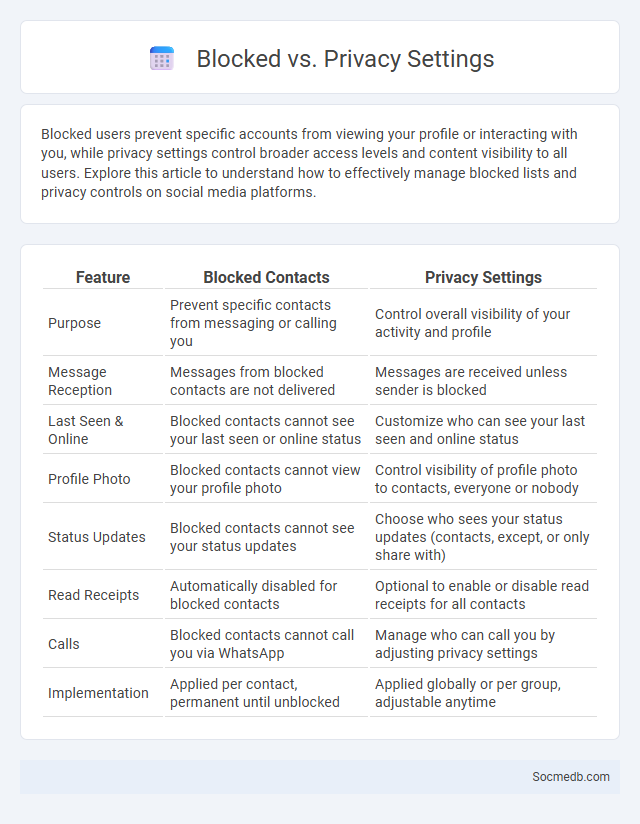
Photo illustration: Blocked vs Privacy Settings
Blocked users prevent specific accounts from viewing your profile or interacting with you, while privacy settings control broader access levels and content visibility to all users. Explore this article to understand how to effectively manage blocked lists and privacy controls on social media platforms.
Table of Comparison
| Feature | Blocked Contacts | Privacy Settings |
|---|---|---|
| Purpose | Prevent specific contacts from messaging or calling you | Control overall visibility of your activity and profile |
| Message Reception | Messages from blocked contacts are not delivered | Messages are received unless sender is blocked |
| Last Seen & Online | Blocked contacts cannot see your last seen or online status | Customize who can see your last seen and online status |
| Profile Photo | Blocked contacts cannot view your profile photo | Control visibility of profile photo to contacts, everyone or nobody |
| Status Updates | Blocked contacts cannot see your status updates | Choose who sees your status updates (contacts, except, or only share with) |
| Read Receipts | Automatically disabled for blocked contacts | Optional to enable or disable read receipts for all contacts |
| Calls | Blocked contacts cannot call you via WhatsApp | Manage who can call you by adjusting privacy settings |
| Implementation | Applied per contact, permanent until unblocked | Applied globally or per group, adjustable anytime |
Understanding Blocked Contacts
Blocked contacts on social media prevent specific users from viewing your profile, sending messages, or interacting with your posts, enhancing your privacy and control over online interactions. Understanding how blocking functions on platforms like Facebook, Instagram, and Twitter helps you manage unwanted communication and maintain a positive digital experience. Your ability to review and modify blocked lists ensures you stay in charge of who can connect with you and access your content.
What Are Privacy Settings?
Privacy settings on social media platforms allow you to control who can see your posts, personal information, and activity. These settings help protect your data by limiting access to friends, followers, or specific groups, enhancing your online security. Adjusting your privacy preferences empowers you to maintain control over your digital footprint and safeguard your personal information from unauthorized users.
The Difference Between Blocking and Privacy Settings
Blocking on social media completely restricts a specific user from viewing your profile, sending messages, or interacting with your content, providing a high level of personal control and security. Privacy settings allow customization of who can see your posts, profile information, or activity without fully cutting off interaction, enabling selective content sharing. Platforms like Facebook, Instagram, and Twitter offer both features, where blocking acts as a strict barrier while privacy settings offer flexible audience control.
How Blocking Works on Popular Platforms
Blocking on popular social media platforms like Facebook, Instagram, and Twitter prevents the blocked user from viewing your profile, sending messages, and interacting with your content. Each platform uses a unique algorithm to enforce blocks, ensuring that blocked users cannot see your posts or comment on them, effectively safeguarding your privacy and online experience. You can manage your block list within the privacy settings, allowing you to control who can access your social media presence effectively.
Impact of Blocking a Contact
Blocking a contact on social media can significantly affect your digital interactions by preventing unwanted messages, comments, and access to your profile, enhancing your online privacy and security. This action helps you maintain control over your social environment, reducing stress and potential conflicts from negative engagements. You regain a sense of safety and can curate your social feed to focus on positive and meaningful connections.
Managing Your Privacy Settings Effectively
Managing your privacy settings on social media platforms is crucial for protecting personal information and controlling who can access your content. Regularly updating your privacy preferences, such as adjusting visibility to friends only and limiting data sharing with third-party apps, helps safeguard your online presence. Utilizing features like two-factor authentication and reviewing app permissions enhances security and reduces the risk of unauthorized access.
When to Block vs Adjust Privacy Settings
Blocking on social media is essential when facing persistent harassment, spam, or unwanted contact that disrupts personal safety and well-being. Adjusting privacy settings is more suitable for controlling who can see posts, limiting data exposure, and managing visibility without severing connections. Implementing privacy controls optimizes online presence, while blocking addresses direct threats or abusive behavior effectively.
Signs You’ve Been Blocked
If you suddenly cannot see a user's profile, posts, or stories on social media platforms like Instagram or Facebook, it is a strong indicator that you may have been blocked. Messaging attempts may fail to deliver, or the chat history might disappear entirely, signaling restricted access. Another sign includes being unable to tag or mention the person in posts and comments, confirming potential block status.
Common Myths About Blocking and Privacy
Blocking on social media does not guarantee complete privacy, as blocked users can still access certain public information or create new accounts to bypass restrictions. Many believe that blocking someone removes all traces of interactions, but posts, comments, or shared content may remain visible to others or stored in backup servers. Privacy settings are crucial alongside blocking for comprehensive control over digital footprints and personal data exposure.
Best Practices for Digital Communication Boundaries
Establishing clear digital communication boundaries on social media enhances your online interactions by promoting respect and preventing burnout. Setting specific times for checking notifications and using privacy settings to control who can contact you helps maintain balance between personal and professional life. Respecting these boundaries ensures effective communication and safeguards your mental well-being in the digital space.
 socmedb.com
socmedb.com